
Allergies are the 6th leading cause of illness in the United States. The National Institute of Health approximates the number of allergy sufferers at 40 to 50 million Americans, with a higher number that remains undiagnosed. (1) Yearly visits to physicians due to allergic symptoms is estimated at 17 million. (2) The overall prevalence of some forms of allergies, such as allergic rhinitis and atopic eczema, are increasing substantially. (3)
Genetic predisposition is clearly indicated in the development of allergies. There is a 40%-60% chance of developing allergies if both parents have allergies, 20%-40% if one parent is allergic, and 5%-15% if neither parent is affected. In addition to genetics, the development of allergies may to due to multi-factorial causes, which includes overexposure to particular substances that initiates an ‘overreaction’ response by the allergic individual’s immune system. Some theories of the increased rate of allergies is that it is due to a decrease in breastfeeding along with early introduction of potentially allergenic foods to an infant’s diet, (4) and high levels of air and water pollution. (5)
The term ‘allergy’ refers to a grouping of symptoms that affects different body systems. The allergic patient may experience symptoms in only one, or several body systems. People may experience allergies that are due to a wide array of antigens (triggering substances), such as foods, pollen, environmental particles, animal dander, dust mites, cigarette smoke, ingredients in soaps, newsprint, latex and almost anything else that a person may come into contact with. Although many of the antigens that provoke allergic reactions are proteins, many non-protein components can illicit allergic reactions, such as toluene diisocyanate found in dry cleaning fluid.(6) The following is a grouping of symptoms that are commonly associated with different body systems.
Respiratory symptoms: stuffy/runny nose, sneezing, coughing, watery eyes, wheezing, recurring ear infections, tickling or sore throat, asthma.
Integumentary symptoms: swelling of hands and feet, itchy, dry, red scaling skin patches, dark circles under the eyes, swollen tongue. Digestive symptoms: bloating, flatulence, diarrhea, constipation, weight loss or gain, burning anal and underarm rash, abdominal discomfort.
Allergic reactions are initiated by the immune system’s over- response to substances it deems as distinct from itself. Although well tolerated by most people, in the allergic person contact with the offending substance (antigen), is the basis of the hypersensitivity reaction. (7) Immunoglobulins are specific antibodies that have the responsibility of tracking down and destroying antigens that are recognized by the body. There are five different classes of antibodies, IgE, IgA, IgG, IgM, and IgD. Each of these specifically attack different categories of antigens. Every antibody is ‘antigen specific’, and is programmed to react to a specific kind of invader. In the case of allergies, these antibodies become overzealous, and begin to recognize substances that are usually benign, as if they were dangerous invaders. Once an antibody recognizes a suspected antigen, it attaches to it and forms an ‘antigen-antibody’ complex. This complex initiates the release of histamines and other chemicals that lead to inflammation, the common theme to all hypersensitivity reactions (allergies). The inflammatory response causes the release of chemical mediators, vasodilation, increased vascular permeability, edema and tissue damage. (8) Allergic reactions can range from a trivial annoyance such as an itchy rash and runny nose, to a fatal incident.
There are four different classes of allergic reactions: Type I (Immediate Hypersensitivity Reactions), Type II (Cytotoxic Reactions), Type III(Immune Complex Mediated Reactions) and Type IV(Cell Dependent Reactions). (9) Type I reactions occur almost immediately after exposure to an antigen, and range from a temporary outbreak of hives, skin rash, headache, GI symptoms, rhinitis, and asthma-like symptoms, to fatal Anaphylactic shock characterized by difficulty breathing, closing of the throat, decreased blood pressure, tachycardia, seizures and loss of consciousness. The symptoms can be local or systemic, depending on the port of entry of the antigen. (10) IgE immunoglobulins are widely believed to be responsible for Type I reactions. However, recent studies report that IgG, previously thought to only be involved with DELAYED reactions, may also be involved in the initiation of Type I reactions. (11) (12) (13)(14) This evidence supports complementary health care practitioners, who have been regularly testing patients for both IgE AND IgG mediated reactions for decades, although most conventional physicians still disregard IgG testing.
Type II- Type IV reactions are referred to as DELAYED reactions, since they can occur 24- 72 hours after encountering the offending substance. They involve IgG, and to some degree IgM, although many allergic reactions do not involve any antigen-antibody complex, but are due to the direct release of histamines and other inflammatory compounds by mast cells and other white blood cells.
Food allergies are widespread, and remain an under-diagnosed phenomena. Delayed food allergies are often the culprit behind eczema, difficulty concentrating, recurrent ear infections, chronic rhinitis and immunodeficiency in both children and adults.(15) Severe reactions to common allergens such as milk, egg, peanut and sesame are on the rise. The threshold needed to trigger a severe reaction can be as low as a molecular amount.(16) Pharmacists can advocate for patients by suggesting that they see a physician who regularly performs both IgG and IgE testing to search for food sensitivities. In addition, pharmacists can instruct clients in keeping a food diary, and practicing avoidance and re-introduction of specific foods, in an attempt to track down offending substances.
Conventional medical treatment of allergies involves the use of a variety of pharmaceutical agents that are mainly focused on the reduction of symptoms. These include antihistamines that stop histamine release, decongestants to constrict the mucous membranes and decrease secretions, cromolyn sodium that interferes with the mast cell release of inflammatory chemicals, and steroidal inhalants. Drug therapies can be useful for acute symptom relief, but do not address the underlying cause of allergies, and often have a variety of adverse effects including insomnia, nervousness, irritability, dry mouth, constipation, urinary retention, rapid heartbeat, blurred vision, drowsiness and dependency.
Naturally oriented practitioners take a different approach. The first line of defense for the allergic individual is to address diet and lifestyle issues. HEPA air filters reduce exposure to mold, pollen, dust mites and dander. Neti pots, small ‘tea-pot’ like devices, are excellent to use as saline irrigators. This removes particle allergens from sensitive mucous membranes, and has been shown to decrease the inflammatory mediators histamine and leukotriene C-4.(17) Pharmacists can recommend the use of air filters and Neti Pots to their clients. The allergic person must avoid foods discovered to initiate an allergic response, while increasing the consumption of anti-inflammatory foods, such as cold water fish, Omega 3 oils, and dark green leafy vegetables. One study examined how the consumption of ALA (alpha-linolenic acid), effects the level of C- reactive protein(CRP), a known marker for inflammation, and found that dietary supplementation with ALA for 3 months significantly decreased CRP.(18) Eliminating food allergens ALSO tends to decrease sensitivity to inhalant allergens. The authors have had numerous clinical reports from patients with seasonal inhalant allergies, who were able to get through their previous ‘allergy season’ without the use of any medications, after removing common foods such as wheat and dairy from their diet. This makes sense, because many grains are in the grass family and cross react with other grass species. Several studies have documented cases of cross reactivity between food and pollen antigens.(19) Stress reduction, through techniques such as meditation and yoga, can help to decrease the frequency and intensity of allergic reactions. Endogenous serum cortisol acts as a natural anti-inflammatory mediator. Stress reduces serum cortisol, which leads to increased inflammation(20).
Nutritional supplements such as vitamin C (500- 1000 mg) and magnesium (400 mg) have shown promise in clinical studies involving asthma patients, and may also be useful for allergies.(21) Other herbs and natural remedies can also be helpful.
Quercetin
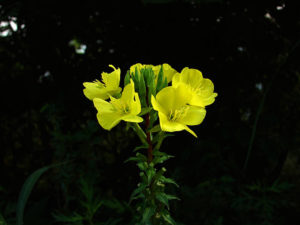
Quercetin is an active bioflavonoid found abundantly in plants, including evening primrose leaf, onion and green tea. It is a strong inhibitor of basophil and mast cell degranulation.(22) Degranulation of mast cells is an active process that requires the influx of calcium, along with an increase in cAMP(adenosine monophospate). This activity leads to phosphorylation of the membrane around mast cell granules, which renders them permeable to water and calcium. The mast cell uses calcium-activated enzymes to assemble contractile microtubules, which pulls the granules towards the cell membrane, where the inflammatory contents are spilled outside the cell, unleashing an allergic reaction.(23) Quercetin prevents calcium from influxing into the cell.(24) Secondary mediators of inflammation, such as arachidonic acid metabolites, are released outside the cell via the action of the enzyme phospholipase A2. (Steroids act as anti-inflammatory agents due to their ability to inhibit phospholipase A-2.) Quercitin inhibits many steps along the eicosanoid membrane pathway, including phospholipase A2 and lipoxygenase.(25) Quercetin taken along with vitamin C has been reported to reduce hay fever symptoms.(26) The authors have used quercetin clinically for a number of pathological processes, including inhalant allergies, food allergies, atopic dermatitis, chronic sinusitis, bronchitis, asthma, serous otitis media reoccurrences, and ITP.
Recommended dosage: 500 -1000 mg three times a day on an empty stomach as a capsule, tablet or nasal spray.
Cautions: Quercitin may raise levels of estradiol and should be used with caution with hormone intervention.(27) Quercetin may inhibit the activity of enzymes that break down Felodipine into an inactive form, thereby raising blood levels of Felodipine.(28)
Baikal Skullcap Root (Scutellaria baicalensis)
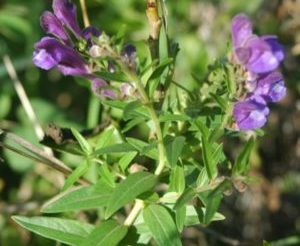
The root of the Chinese Skullcap, Radix Scutellaria baicalensis, called Huang Qin in traditional Chinese Medicine, has been used for thousands of years, especially for inflammation and high fevers. It contains the flavonoids baicalin and wogonin, well researched for their anti-allergy and free radical scavenging properties.(29) (30) These components are similar in structure and mechanism of action to Quercetin.(31) Another component of Scutellaria, baicalein, has even a stronger anti-inflammatory and anti-allergic effect, specifically reducing leukotriene B4 and C4 production by inhibiting lipoxygenase.(32)
The dose is typically 2-6g/day of the dried root or 4 to 12 ml per day of a 1:2 fluid extract.
Cautions: No specific adverse reactions have been reported. However, due to structural similarity to quercetin similar cautions may apply.
Nettles (Urtica dioica)
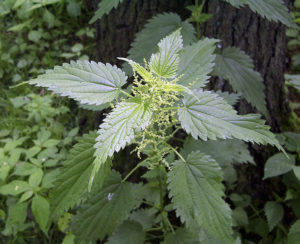
Stinging Nettles is a common plant found in damp waste areas around the United States and Europe. Touching the stingers on the nettle plant, causes an allergic reaction, probably due to the formic acid found in the stingers which initiates a localized histamine release. Traditional herbalists have historically recommended the juice of the nettle as an antidote to the rash caused by the nettle stinger, as well as the prophylactic use of nettle tea for spring allergies. In addition, the homeopathic remedy made from nettle,Urtica, is successfully used for hives and other allergic skin irritations. One preliminary study found that freeze dried nettles were helpful for symptoms of allergic rhinitis.(33) The authors have also encouraged the use of nettle herb for allergic patients, with favorable results.
Typical dosage is 600 mg dried herb or 2-4 ml per day of fluid extract in divided doses.
Cautions: may occasionally cause mild gastrointestinal irritation when used internally.
Mimosa (Albizzia lebbeck, Albizzia kalkora)
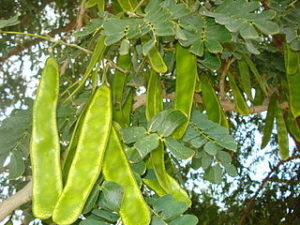 Albizzia is a member of the mimosa family that has been used in Ayurvedic practice for asthma and dermatitis, and as a sedative in Traditional Chinese Medicine. Several studies were performed on a bark extract of this plant, which showed advantageous actions against allergic symptoms, including anaphylaxis,(34) atopic allergy(35) and gastrointestinal allergic symptoms such as diarrhea.(36) Albizzia has been shown to stabilize mast cell degranulation , depress levels of anti-allergy antibodies, and decrease the overaggressive action of T and B lymphocytes.
Albizzia is a member of the mimosa family that has been used in Ayurvedic practice for asthma and dermatitis, and as a sedative in Traditional Chinese Medicine. Several studies were performed on a bark extract of this plant, which showed advantageous actions against allergic symptoms, including anaphylaxis,(34) atopic allergy(35) and gastrointestinal allergic symptoms such as diarrhea.(36) Albizzia has been shown to stabilize mast cell degranulation , depress levels of anti-allergy antibodies, and decrease the overaggressive action of T and B lymphocytes.
A therapeutic dose of Albezzia is 3-6 ml/day of the 1:2 extract. (37)
Cautions: No adverse reactions have been reported.
Coleus (Coleus forskohlii )
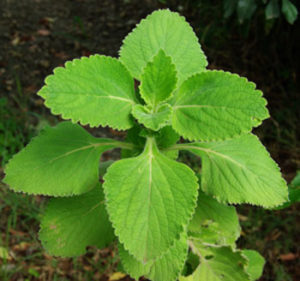
Coleus is a member of the mint family, and grows wild in Thailand , India and other areas. It has been used in traditional Ayurvedic medicine for allergic symptoms such as bronchitis and breathing difficulties.(38) In 1974 Hoechst Pharmaceuticals, along with the Indian Central Drug Research Institute, conducted studies on Coleus extract and found that it had muscle relaxant and antihypertensive effects. The active constituent forskolin, extracted from the root of Coleus forskohlii , has been found to increase Cyclic AMP(39)(40), which causes bronchial relaxation. Forskolin has the added advantage of being receptor independent, which avoids the desensitization caused by the repeated use of B-adrenergic agonist pharmaceuticals.(41) Forskolin also inhibits the release of histamine from basophils, which decreases the allergic response.(42)
The recommended dosage of Coleus is 50 mg 2 times a day of an extract standardized to contain 18% forskolin.
Cautions: Coleus may lower blood pressure.
REFERENCES
- American Academy of Allergy, Asthma and Immunology (AAAAI). The Allergy Report: Science Based Findings on the Diagnosis & Treatment of Allergic Disorders, 1996-2001.
- CDC. Fast Stats A-Z, Vital and Health Statistics, Series 10, no. 13. 1999
- The International Study of Asthma and Allergies in Childhood (ISAAC) Steering Committee. “Worldwide variation in prevalence of symptoms of asthma, allergic rhinoconjunctivitis, and atopic eczema: ISAAC.” Lancet 351: 1225-32. 1998.
- van Odijk J, Kull I, Borres MP, et al., Breastfeeding and allergic disease: a multidisciplinary review of the literature (1966-2001) on the mode of early feeding in infancy and its impact on later atopic manifestations., Allergy. 2003 Sep;58(9):833-43.
- Levetin E, Van de Water P. , Environmental contributions to allergic disease. Curr Allergy Asthma Rep. 2001 Nov;1(6):506-14
- Rea, William J. Chemical Sensitivity: Volume 1 Chapter 2 Lewis Publishers/ CRC press, Boca Raton, FL pg 8
- Robbins, Cotran, & Kumar. Pathologic Basis of Disease,3rd Edition; Hypersensitivity reactions W.B. Saunders, Philadelphia, PA, 1984, pg 163.
- Suen, Raymond & Gordan, Shalima; A Critical Review of IgG Immunoglobulins and Food Allergy-Implications in Systemic Health ;A Paper by US BioTek Labs, Seattle, WA, 2003, page 1.
- Murray, Michael; Pizzorno, Joseph. Encyclopedia of Natural Medicine, Prima Publishers, Rocklin, CA., 1998, p. 467-468
- Robbins, Cotran, & Kumar. Pathologic Basis of Disease,3rd Edition; Hypersensitivity reactions W.B. Saunders, Philadelpia, PA, 1984, pg 164.
- Tkaczyk, C., Okayama Y., Woolhisser, M.R., et al; Activation of Human Mast Cells through the High Affinity IgG Receptor. Mol Immunol, 38(16-18):1289, 2002.
- Okayama, T., Hagaman, D., Metcalfe, D. ; A Comparison of Mediators Released or Generated by IFN-Gamma-Treated Human Mast Cells Following Aggregation of Fcgamma RI or F Cepsilon RI.J. Immunology 166(7):4705-12, 2001
- Parish, WE: Short term Anaphylactic IgG Antibodies in Human Sera. Lancet, 2:591, 1970.
- Pepys.,J et al: Clinical Correlations Between Long-Term (IgE) and Short Term (IgG S-TS) Anaphylactic Antibodies in Atopic and “Non-Atopic Subjects with Respiratory Allergic Disease. Clin. Allergy, 9:645, 1979
- Latcham F, Merino F, Lang A A consistent pattern of minor immunodeficiency and subtle enteropathy in children with multiple food allergy. J Pediatr. 2003 Jul;143(1):39-47.
- Morisset M, Moneret-Vautrin D, Kanny G, et al. Thresholds of clinical reactivity to milk, egg, peanut and sesame in immunoglobulin E-dependent allergies: evaluation by double-blind or single-blind placebo-controlled oral challenges. Clin Exp Allergy. 2003 Aug;33(8):1046-1051
- Georgitis J.W., Nasal typerthermia and simple irrigation for perennial rhinitis: changes in inflammatory mediators. Chest1994:106;1487-92
- Rallidis LS, Paschos G, Liakos GK. Dietary alpha-linolenic acid decreases C-reactive protein, serum amyloid A and interleukin-6 in dyslipidaemic patients., Atherosclerosis. 2003 Apr;167(2):237-42.
- Enrique E, Cistero-Bahima A, Bartolome B, et al. Platanus acerifolia pollinosis and food allergy. Allergy. 2002 Apr;57(4):351-6
- Laube BL, Curbow BA, Costello RW, et. al. A pilot study examining the relationship between stress and serum cortisol concentrations in women with asthma. Respir Med. 2002 Oct;96(10):823-8
- R. Jaber, Respiratory and allergic diseases: from upper respiratory tract infections to asthma. Prim Care Clin Office Prac29(2002) 231-61
- M. Amellal, C. Bronner,F. Briancon et al. Inhibition of Mast Cell Histamine Release by Flavonoids and BioFlavonoids. Planta Medica, 51:16-20, 1985.
- Robbins S.,Cotran,S, and Kumar, V. Pathological Basis of Disease 3rd edition. WB Saunders Company Philadelphia, PA, pg 164-65.
- Nishino, H., Naitoh, E. Iwashima, A et al. Quercetin interacts with calmodulin, (a calcium regulatory protein) Experentia 40:184-5, 1984.
- Yoshimoto, T.,Furukawa M. Yamamoto., S. et al.;Flavonoids: Potent inhibitors of arachidonate 5-lipoxygenase. Biochem Biophys Res Common 116:612-8, 1983.
- Middleton E, Drzewicki G. Effect of ascorbic acid and flavonoids on human basophil release. J Allerg Clin Immunol. Jan1992:278.
- Schubert W, Eriksson U, Edgar B, et al. Flavonoids in grapefruit juice inhibit the in vitro hepatic metabolism of 17 beta-estradiol. Eur J Drug Metab Pharmacokinet 1995;3:219–24.
- Miniscalco A, Lundahl J, Regardh CG. Inhibition of dihydropyridine metabolism in rat and human liver microsomes by flavonoids found in grapefruit juice. J Pharmacol Exp Ther 1992;261:1195–9.
- Bochorakova H, Paulova H, Slanina J, et al. Main flavonoids in the root of Scutellaria baicalensis cultivated in Europe and their comparative antiradical properties. Phytother Res. 2003 Jun;17(6):640-4
- Lin CC., Shieh DE., The anti-inflammatory activity of Scutellaria rivularis extracts and its active components, baicalin, baicalein and wogonin. American Journal of Chinese Medicine 1996;24(1):31-6
- Bone, Kerry: Clinical Applications of Ayurvedic and Chinese Herbs-Monographs for the Western Herbal Practitioner , Phytotherapy Press, Warwick, Queensland Australia (1996) pp 75-79.
- Chang, HM :Pharmacology and Applications of Chinese Materia Medica, Vol 2, World Scientific, Singapore (1987)
- Mittman P. Randomized,double-blind study of freeze-dried Urtica dioica in the treatment of allergic rhinitis. Planta Medica 56:44-7, 1990
- Tripathi RM, Sen PC, Das PK Further studies on the mechanism of the anti-anaphylactic action of Albizzia lebbeck, an Indian indigenous drug. J Ethnopharmacol. 1979 Dec;1(4):397-400.
- Tripathi RM, Sen PC, Das PK Studies on the mechanism of action of Albizzia lebbeck, an Indian indigenous drug used in the treatment of atopic allergy. J Ethnopharmacol. 1979 Dec;1(4):385-96.
- Besra SE, Gomes A, Chaudhury L Antidiarrhoeal activity of seed extract of Albizzia lebbeck Benth. Phytother Res. 2002 Sep;16(6):529-33.
- Bone, Kerry: Clinical Applications of Ayurvedic and Chinese Herbs-Monographs for the Western Herbal Practitioner, Phytotherapy Press, Warwick, Queensland Australia (1996) pp 94
- Abraham, Z. (1981) Glimpses of Indian Ethnobotany (S.K. Jain, ed) p 315. Oxford and IBM Publishing Co., Bombay, India
- Seamon KB, Daly JW. Forskolin: a unique diterpene activator of cAMP-generating systems. J Cyclic Nucleotide Res. 1981;7:201–224
- Laurenza A, Sutkowski EM, Seamon KB. Forskolin: a specific stimulator of adenylyl cyclase or a diterpene with multiple sites of action? Trends Pharmacol Sci. 1989;10:442–447
- Robbers, James E., Marilyn K. Speedie, and Varro E. Tyler. 1996. Pharmacognosy and Pharmacobiotechnology. P 88. Williams & Wilkins. ISBN: 0-683-08500-X.
- Marone G, Columbo M, Triggiani S, et al. Forskolin inhibits the release of histamine from human basophils and mast cells.Agents Actions. 1986;18:96–99.
Ellen Kamhi , The Natural Nurse®, (www.naturalnurse.com) and Eugene Zampieron (www.drznaturally.com) are the authors ofThe Natural Medicine Chest and Arthritis, The Alternative Medicine Guide. Dr. Zampieron is a Professor of Botanical Medicine at Bridgeport College of Naturopathic Medicine and Ellen Kamhi is a Professional Herbalist with Nature’s Answer in Hauppauge, NY.
